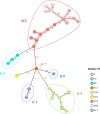Molecular characterization of multidrug resistant Acinetobacter baumannii clinical isolates from Alexandria, Egypt
- PMID: 37545857
- PMCID: PMC10399577
- DOI: 10.3389/fcimb.2023.1208046
Molecular characterization of multidrug resistant Acinetobacter baumannii clinical isolates from Alexandria, Egypt
Abstract
Carbapenem resistant Acinetobacter baumannii is a major global concern, especially in countries of the Middle East and North Africa, where the antibiotic resistance rates are on the rise. The aim of this study was to study the genomic characteristics and antimicrobial susceptibility profile of thirty-six multidrug resistant A. baumannii clinical isolates obtained in hospitals from Alexandria, Egypt. Antibiotic resistance rates were estimated by determination of Minimum Inhibitory Concentrations. Carbapenemase genes, other antibiotic resistance genes and virulence factors were then screened by the use of Whole Genome Sequencing. Isolates were also subjected to Multi Locus Sequence Typing (MLST) using the Pasteur Scheme and to core genome MLST to study their clonal relatedness. In addition, plasmid analysis was performed by the use of a commercial kit and S1- Pulsed Field Gel Electrophoresis, and Hybridization experiments with DIG-labeled DNA probes for bla NDM-1, blaPER-7 and bla GES-like were performed to locate these genes. The majority of isolates were resistant to β-lactams (including carbapenems), fluoroquinolones, aminoglycosides and trimethoprim; and some showed resistance to cefiderocol and minocycline. We identified 8 different bla OXA-51-like variants including bla OXA-51, bla OXA-64, bla OXA-65, bla OXA-66, bla OXA-68, bla OXA-91, bla OXA-94 and bla OXA-336; bla OXA-23, bla NDM-1, bla PER-7, bla GES-like and bla ADC-like and other antibiotic resistance genes, some of these genes were within transposons or class 1 integrons. Multiple virulence factors responsible for adherence, biofilm production, type II and type VI secretion systems, exotoxins, exoenzymes, immune modulation and iron uptake were observed and 34 out of 36 isolates showed motility. Thirty-five out of 36 isolates clustered with International Clones 2, 4, 5, 7, 8 and 9; and 9 STs were identified including ST570, ST2, ST600, ST15, ST113, ST613, ST85, ST158, ST164. Plasmids ranging in size from 1.7 to 70 kb were found; bla NDM-1 and blaPER-7 genes were located in the chromosome and bla GES-like genes were simultaneously located in the chromosome and in a plasmid of 70kb. In conclusion, this study revealed a wide spectrum of antibiotic resistance genes and a variety of lineages among A. baumannii isolated in hospitals from Alexandria, and highlights the importance of investigating the molecular epidemiology to control the spread of multi-drug resistant isolates.
Keywords: Acinetobacter baumannii; antibiotic resistance; carbapenemase genes; molecular epidemiology; whole genome sequencing.
Copyright © 2023 Sánchez-Urtaza, Ocampo-Sosa, Molins-Bengoetxea, El-Kholy, Hernandez, Abad, Shawky, Alkorta and Gallego.
Conflict of interest statement
The authors declare that the research was conducted in the absence of any commercial or financial relationships that could be construed as a potential conflict of interest.
Figures




References
Publication types
MeSH terms
Substances
LinkOut - more resources
Full Text Sources
Molecular Biology Databases

